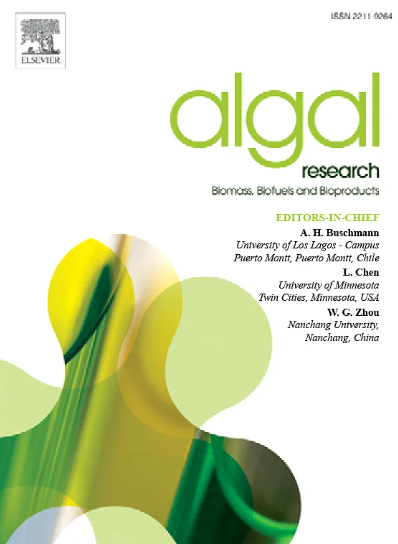Exopolysaccharide from Haematococcus pluvialis enhances photosynthesis, biomass and astaxanthin accumulation
IF 4.6
2区 生物学
Q1 BIOTECHNOLOGY & APPLIED MICROBIOLOGY
Algal Research-Biomass Biofuels and Bioproducts
Pub Date : 2025-05-30
DOI:10.1016/j.algal.2025.104120
引用次数: 0
Abstract
Haematococcus pluvialis is recognized as the prime biological source of natural astaxanthin. However, the physiological and metabolic effects of H. pluvialis exopolysaccharide (HPEPS), which is derived from both secretion and cell wall dissolution during cell growth and transformation, remain unclear. This study systematically elucidated the regulatory effects of HPEPS on astaxanthin biosynthesis in H. pluvialis through physiological and metabolomics analyses, and preliminary characterization of its structure was also performed. Under high light stress, exogenous supplementation of 220 mg/L HPEPS induced cell division arrest and increased cell diameter to 1.25-fold of the original size, thereby providing space for biomass and astaxanthin accumulation. Concurrently, it enhanced photosynthetic efficiency and maintained energy metabolic homeostasis, leading to 1.36-fold, 1.82-fold, and 2.6-fold increases in biomass, astaxanthin yield, and astaxanthin content, respectively. Integrated metabolomics analysis revealed that HPEPS activation enhances carbon assimilation, photorespiration, and glyoxylate cycle pathways to enhance precursor supply for astaxanthin biosynthesis. Structural elucidation further identified HPEPS as a heteropolysaccharide primarily containing guluronic acid (GulA, 37.4 %), galactose (18.9 %), and arabinose (12.0 %). Notably, this work reports the first detection of GulA in microalgal exopolysaccharides. Overall, this study not only provides a theoretical basis for elucidating the structural composition and physiological role of HPEPS, but also develops a new approach to optimize the production of natural astaxanthin.
雨红球菌的胞外多糖提高了光合作用、生物量和虾青素的积累
雨红球菌被认为是天然虾青素的主要生物来源。然而,水蛭胞外多糖(HPEPS)的生理和代谢作用尚不清楚,它来源于细胞生长和转化过程中的分泌和细胞壁溶解。本研究通过生理代谢组学分析系统阐明了HPEPS对雨水杨虾青素生物合成的调控作用,并对其结构进行了初步表征。在强光胁迫下,外源添加220 mg/L HPEPS诱导细胞分裂停止,细胞直径增加到原来的1.25倍,从而为生物量和虾青素积累提供了空间。同时提高了光合效率,维持了能量代谢稳态,使生物量、虾青素产量和虾青素含量分别提高了1.36倍、1.82倍和2.6倍。综合代谢组学分析显示,激活HPEPS可增强碳同化、光呼吸和乙醛酸循环途径,从而增加虾青素生物合成的前体供应。结构分析进一步确定HPEPS是一种主要含有古鲁醛酸(guluronic acid, 37.4%)、半乳糖(18.9%)和阿拉伯糖(12.0%)的杂多糖。值得注意的是,这项工作报道了首次在微藻胞外多糖中检测到GulA。综上所述,本研究不仅为阐明HPEPS的结构组成和生理作用提供了理论依据,而且为优化天然虾青素的生产开辟了新的途径。
本文章由计算机程序翻译,如有差异,请以英文原文为准。
求助全文
约1分钟内获得全文
求助全文
来源期刊

Algal Research-Biomass Biofuels and Bioproducts
BIOTECHNOLOGY & APPLIED MICROBIOLOGY-
CiteScore
9.40
自引率
7.80%
发文量
332
期刊介绍:
Algal Research is an international phycology journal covering all areas of emerging technologies in algae biology, biomass production, cultivation, harvesting, extraction, bioproducts, biorefinery, engineering, and econometrics. Algae is defined to include cyanobacteria, microalgae, and protists and symbionts of interest in biotechnology. The journal publishes original research and reviews for the following scope: algal biology, including but not exclusive to: phylogeny, biodiversity, molecular traits, metabolic regulation, and genetic engineering, algal cultivation, e.g. phototrophic systems, heterotrophic systems, and mixotrophic systems, algal harvesting and extraction systems, biotechnology to convert algal biomass and components into biofuels and bioproducts, e.g., nutraceuticals, pharmaceuticals, animal feed, plastics, etc. algal products and their economic assessment
 求助内容:
求助内容: 应助结果提醒方式:
应助结果提醒方式:


